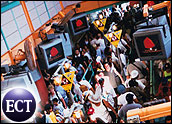
Consumer loyalty has become such a ubiquitous goal for marketers that its definition is murky at best. Ten years ago, a loyal customer participated with a chosen brand more frequently than the average shopper.
For marketers, the term has evolved to encompass frequency, recency of interaction, and monetary value — typically of the customer’s transaction. For a while, customer satisfaction occupied the dais as the chief metric of consumer loyalty. The understanding of just what loyalty is, though, is shifting — and that means methods for building it are changing too. Following are some dos and don’ts that take current conditions into account.
Customer Value
A sophisticated assessment of customer value goes a long way. “Understand who your best customers are and spend your limited sources based on the lifetime value of a customer,” said Steve Georgeou, a loyalty consultant and president of Geocom. “The more valuable you are to the company, the more it should spend on benefits and marketing to you.”
“Customer lifetime value” may just be the latest synonym for loyalty, but it encompasses a sophisticated and predictive view of customer relationships, with incremental profitability as its payoff.
Harrah’s casinos, for example, price rooms according to the value of the guest, dropping room rates for high rollers and frequent visitors and raising them for relatively uninvolved customers who may otherwise not return a profit to the company.
“Recognize your best customers, tell them they are important, and treat them differently,” Georgeou told CRM Buyer. One goal is to accord them higher levels of service and special benefits. “Many programs treat everyone equally — and everyone is not equal,” he added.
For example, United Airlines hosts a somewhat secretive, super-elite bevy of benefits called “Global Services,” which includes personal reservations agent assistance and special airport lounge access, as well as meet-and-greet customer service curbside and at the gate.
Georgeou commends this example of rewarding desired consumer behavior — in the case of United Airlines, frequent and expensive business travel. Still, he sees glaring instances of don’ts among airlines, too.
“Don’t give an incentive or reward to a valued customer and then make it difficult to use,” he said. For instance, limited availability of airline award seats occurs all too frequently in frequent-flier programs.
Some carriers, hurt by customer dissatisfaction over mileage programs, are experimenting with different award models. For example, Air Canada has made all of its seats available for Aeroplan awards, dropping capacity controls. Some seats may cost more than 15,000 miles, but the airline wants to maintain the best customer relationships and profit margins.
Continuing ROI
As loyalty programs mature and grow in prevalence, marketers need numbers to back their efforts. The most appropriate dos and don’ts center around finances, said Paul Lafortune, senior associate at PrediXys, a firm that forecasts the ROI (return on investment) of loyalty programs.
As an increasing number of competing firms indulge shared customers or shower brand-vulnerable shoppers with perks, it’s not enough for loyalty initiatives to be affordable; marketers need to know they’ll engage a critical mass and turn a profit.
“Measure and anticipate results and ROI before launching any program so as to avoid any bad surprises thereafter,” Lafortune told CRM Buyer. “There are ways nowadays to estimate potential participation levels, interests in a program, and ROI of several concepts prior to launch.
“A program is a strategic initiative — not a short-term commitment,” continued Lafortune. Loyalty efforts don’t end with customer acquisition and measurable interaction with the brand. They mark the beginning of a relationship that gathers information about customer habits and behavior. To attract corporate funding and to generate a profit, loyalty programs must be adjusted to continually satisfy consumers.
Encouraging Stickiness
The initial goal of the Gold Points Reward Network — which includes T.G.I. Friday’s and Italianni’s restaurants, Radisson Hotels & Resorts, Park Plaza Hotels & Resorts, and Country Inns & Suites by Carlson — were to reward everyday consumer spend. Carlson didn’t enter the network for purely philanthropic reasons, however. It sought to leverage customer relationships across the corporation’s properties, increasing stickiness and reinforcing positive experiences brand by brand.
Over the years, Gold Points has opened its arms to e-tailers and others. In addition to serving as a brand platform, it is an affordable way for smaller brands to thank customers and encourage long relationships with them. “Brands that once couldn’t or wouldn’t launch standalone programs now are able to,” said Jerry Rash, general manager of Gold Points.
“Successful loyalty programs must enhance the brand,” he told CRM Buyer. “Developing a solid brand positioning and consumer value proposition that attracts key [marketing] partners and [consumer] members remains key to coalition program success.” A strong brand and compelling value proposition must exist in standalone loyalty programs, as well.
Echoing Lafortune’s comments, Rash noted that a rosy-cheeked, healthy brand by itself will not signal sustainable consumer loyalty. “Financial viability is a key issue for all loyalty programs; it just gets more complex in coalition programs — developing a financial model that provides solid payback to [consumer] members for their loyalty while achieving the financial objectives of each of its partners.”
Consumer loyalty is hard-won these days, not only because rewards programs have become near commodities but because success depends on doing the right things and shrugging off old, bad habits.





















































Social CRM
See all Social CRM